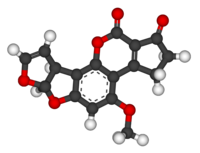Aflatoxin B1
 Chemical structure of (–)-Aflatoxin B1
|
|
 3D Structure of aflatoxin B1
|
|
| Names | |
|---|---|
|
IUPAC name
(6aR,9aS)-2,3,6a,9a-Tetrahydro-4-methoxy-1H,11H-cyclopenta[c]furo[3',2':4,5]furo[2,3-h][1]benzopyran-1,11-dione
|
|
| Other names
NSC 529592
|
|
| Identifiers | |
|
3D model (Jmol)
|
|
| ChemSpider | |
| ECHA InfoCard | 100.013.276 |
|
PubChem CID
|
|
|
|
|
|
| Properties | |
| C17H12O6 | |
| Molar mass | 312.28 g·mol−1 |
| Hazards | |
| Main hazards | Very Toxic |
|
Except where otherwise noted, data are given for materials in their standard state (at 25 °C [77 °F], 100 kPa).
|
|
|
|
|
| Infobox references | |
Aflatoxin B1 is an aflatoxin produced by Aspergillus flavus and A. parasiticus. It is an incredibly potent carcinogen with a TD50 0.0032 mg/kg/day in rats. This carcinogenic potency varies across species with some, such as rats, seemingly much more susceptible than others, such as monkeys. Aflatoxin B1 is a common contaminant in a variety of foods including peanuts, cottonseed meal, corn, and other grains; as well as animal feeds. Aflatoxin B1 is considered the most toxic aflatoxin and it is highly implicated in (HCC) in humans. In animals, aflatoxin B1 has also been shown to be mutagenic,teratogenic, and to cause immunosuppression. Several sampling and analytical methods including thin-layer chromatography (TLC), high-performance liquid chromatography (HPLC), mass spectrometry, and enzyme-linked immunosorbent assay (ELISA), among others, have been used to test for aflatoxin B1 contamination in foods. According to the Food and Agriculture Organization (FAO), the worldwide maximum tolerated levels of aflatoxin B1 was reported to be in the range of 1–20 µg/kg in food, and 5–50 µg/kg in dietary cattle feed in 2003.
Aflatoxin B1 is mostly found in contaminated food and humans are exposed to aflatoxin B1 almost entirely through their diet. Occupational exposure to aflatoxin B1 has also been reported in swine and poultry production. While aflatoxin B1 contamination is common in many staple foods, its prodcution is maximized in foods stored in hot, humid climates. Exposure is therefore most common in Southeast Asia, South America, and Sub-Saharan Africa.
Aflatoxin B1 can permeate through the skin. Dermal exposure to this aflatoxin in particular environmental conditions can lead to major health risks. The liver is the most susceptible organ to aflatoxin B1 toxicity. In animal studies, pathological lesions associated with aflatoxin B1 intoxication include reduction in weight of liver, vacuolation of , and hepatic carcinoma. Other liver lesions include enlargement of hepatic cells, fatty infiltration, necrosis, hemorrhage, fibrosis, regeneration of nodules, and bile duct proliferation/hyperplasia.
...
Wikipedia
